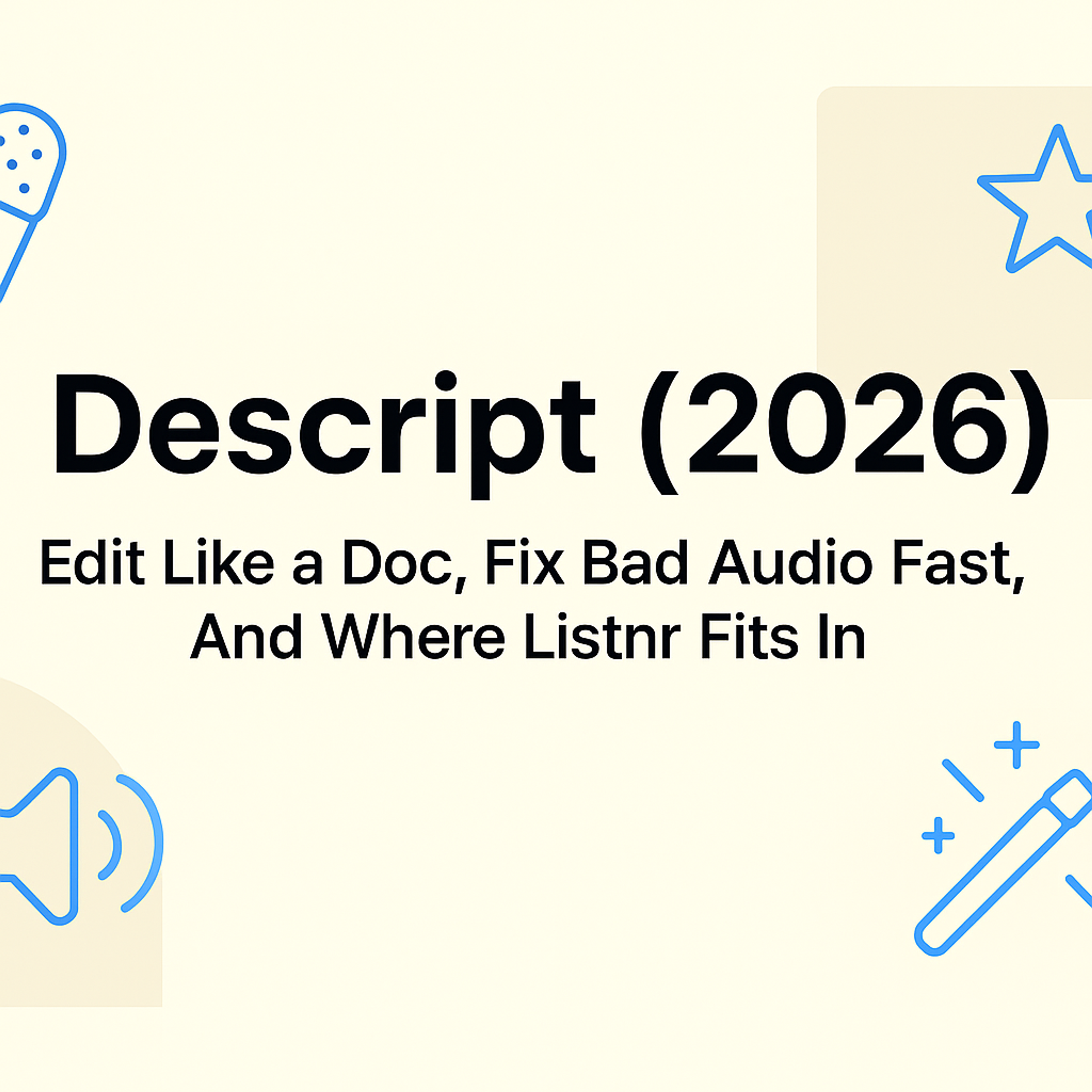Most people meet Descript the moment they get tired of scrubbing timelines.
You record a call, upload it, and suddenly you are deleting filler words, moving paragraphs, and cutting entire sections just by editing text. No more zooming into waveforms to slice out one “uh” at 0.7 seconds.
Descript is brilliant at one thing: making real human audio and video less painful to work with.
If you are running a serious content machine - faceless channels, courses, training libraries, product explainers, UGC ads - you eventually hit a different question:
Where does Descript stop, and where should you switch to AI-native voiceover with Listnr instead?
This is the operator’s cut.
What is Descript?
Descript is an all-in-one audio and video editing software that offers a plethora of features aimed at simplifying and enhancing the editing process. Its standout feature is the ability to transcribe audio and video files with remarkable accuracy. By converting spoken words into text, Descript allows users to edit their content as easily as editing a word document. This is a game-changer for podcasters and video editors who want to streamline their editing processes.
TL;DR
Use Descript when:
- You are recording real humans: podcasts, interviews, webinars, founder videos.
- You want to edit by text instead of by waveform.
- You need AI cleanup for rough recordings.
Use Listnr when:
- You want clean, controllable voiceovers from scripts without touching a mic.
- You are scaling faceless YouTube, Thinkific/Teachable courses, onboarding, docs, training, and ads.
- You care about consistency, multilingual support, and clear commercial rights.
Most serious teams end up with both:
Descript for human-first content.
Listnr for system-first, script-first content.
What Descript Actually Is
Descript is an AI-powered audio and video editor built around transcripts instead of traditional timelines.
Core things it does well:
- Turns your recordings into an editable script.
- Lets you cut, move, and trim content by editing text.
- Removes filler words and silences in one click.
- Cleans up noisy audio.
- Records screen, webcam, and remote guests.
- Offers Overdub to recreate your own voice for small fixes.
Think: Google Docs plus a basic editing suite, aimed at people who work with spoken content.
Key Features (Operator View)
1. Text-based editing
You drop in your file, it transcribes, and you:
- Delete a sentence in text → it’s gone from the track.
- Move a paragraph → your clip order changes with it.
For podcasts, interviews, webinars: this is stupidly efficient.
2. Filler word and silence removal
One-click removal of:
- “Um”, “uh”, “like”, “you know”
- Long awkward pauses
Less manual cleanup, more coherent hosts.
3. Studio-style cleanup
Descript’s AI cleanup can:
- Reduce background noise and echo
- Level out volume
- Make rough recordings sound closer to something recorded on a decent mic
Perfect when a guest has trash audio and you cannot redo it.
4. Recording and collaboration
You get:
- Remote recording links
- Multitrack sessions
- Comments and version history
Good enough to run a podcast or interview show end-to-end.
5. Overdub (voice cloning for yourself)
You can:
- Train a model of your own voice
- Fix small screwups by typing new words instead of re-recording an entire take
Useful as a patch, not a full-blown synthetic voice strategy.
Where Descript Shines
Use Descript as your default when:
- Real people are the point (hosted podcasts, expert interviews, AMAs).
- You publish recurring shows and want to kill edit time.
- You are cleaning recorded lessons or talks you already shot.
- You want a simple “record → edit → publish” hub instead of five different tools.
If it involves real voices and you already have the footage, Descript is a win.
Where Descript Struggles For Voiceover At Scale
For a scripted, scalable content engine, Descript alone starts to hurt.
1. Script-first vs record-first
Descript assumes you record, then edit.
But for:
- faceless channels,
- product explainers,
- help-center walkthroughs,
- course modules,
- localized content,
- ad variants,
the efficient workflow is:
Write → Generate → Fix → Publish
You should not be firing up a mic for every tweak and every version.
2. Multiple brands, multiple voices
Agencies and product companies need:
- Different voice profiles per client.
- Different tones per series.
- A clear yes/no on commercial usage.
Overdub is great for “my own voice, patched.” It is not designed as a giant safe catalog of production voices.
3. Multilingual needs
If you want:
- English, Spanish, Hindi, Arabic, French, etc
- Same script, same tone, different markets
you need something built from the ground up for multilingual AI narration. Descript is not that.
4. Volume and iteration
Updating:
- 120 lessons,
- 300 tutorials,
- 40 hooks per week
should not involve re-recording or manually re-editing timelines. You want to tweak the script, re-generate, and be done.
That is the zone where Listnr is built to be boringly reliable.
Pros and Cons of Descript
Pros:
- User-Friendly Interface: Descript's interface is intuitive, making it accessible even for beginners. The ability to edit audio and video by simply editing text is a game-changer.
- Transcription-Based Editing: The ability to transcribe audio and video files into text allows for straightforward and efficient editing, much like editing a word document.
- Overdub: This AI voice cloning feature allows users to create a text-to-speech model of their own voice, making quick corrections without re-recording.
- Studio Sound: Enhances audio quality by reducing background noise and improving clarity, which is particularly useful for remote recordings.
- Multitrack Editing: Supports complex projects with multiple audio tracks, making it suitable for detailed and professional work.
- Templates and Tutorials: Offers various templates and extensive tutorials, which are helpful for new users to get started and explore the software’s capabilities.
- Integration with Other Tools: Descript integrates well with other popular tools like Final Cut and Canva, enhancing its versatility.
- Screen Recording and Video Editing: Provides robust video editing tools, including screen recording and green screen effects, which are beneficial for content creators on platforms like YouTube and TikTok.
- Automated Features: Features like automatic removal of filler words and efficient transcription save a significant amount of editing time.
- Cross-Platform Availability: Available on both Windows and Mac, catering to a wide range of users.
Cons:
- Pricing: While Descript offers a free plan, the advanced features and higher transcription limits are available only in the paid plans, which might be costly for some users.
- Watermark on Free Plan: The free plan includes a watermark on exported videos, which can be a drawback for professional use.
- Advanced Features: Although the basic features are easy to use, some of the more advanced functionalities, like multitrack editing and AI voice cloning, may require time to master.
- Accuracy Variability: While Descript’s transcription is generally accurate, it may occasionally misinterpret words, especially in recordings with heavy accents or background noise.
- Resource Intensive: Descript can be resource-intensive, especially when handling large files or complex projects, which might slow down performance on less powerful computers.
- Template Flexibility: Some users might find the customization options for templates and certain features somewhat limited compared to other specialized editing software.
- Voice Cloning Ethical Concerns: The Overdub feature, while innovative, raises ethical concerns about voice cloning and potential misuse.
Descript vs Listnr (The Real Division Of Labor)
Use Descript for:
- Podcasts and interview shows
- Founder videos and talking-head content
- Webinars, panels, internal calls you want to polish
- Any situation where authenticity of the real speaker matters
Use Listnr for:
- Faceless YouTube channels
- Thinkific / Teachable / Kajabi courses
- SaaS and product onboarding flows
- Documentation and feature explainers
- UGC ad voiceovers
- Multi-language and multi-brand voice libraries
Listnr gives you:
- A large catalog of non-celebrity, commercially safe voices
- Fine control over speed, tone, pauses, emphasis
- Fast regeneration when a script or UI changes
- A setup that scales instead of collapsing when volume goes up
The healthy stack in 2026 is not “pick one.” It is:
Real humans + Descript.
Systematic scripts + Listnr.
Quick Decision Checklist
For any new content stream, ask:
- Is the main value my personality or my information?
- Is this a one-off piece or part of a repeatable system?
- Do I need multiple voices, accents, or languages?
- Will I be updating this content often?
- If this channel 10x-es, does my current workflow survive?
If it is human-first and episodic → Descript.
If it is system-first and scalable → Listnr.
FAQs
Can Descript replace AI voiceover tools completely?
No. It is an elite editor for recorded voices, not a full synthetic voice engine for every use case.
Can I use both without creating chaos?
Yes. Use Descript for recording/editing. Use Listnr for scripted, repeatable narration. Keep scripts in one place and feed them into whichever tool fits the job.
When should I switch from my own voice to Listnr voices?
When recording becomes your bottleneck, or when you need multiple consistent voices and languages across a growing content library.

About Ananay Batra
Founder and CEO @ Listnr Inc
Ananay is the Founder & CEO of Listnr AI, he started Listnr with $100 in the bank back in 2020 and scaled it to 3mn+ users across 200 countries and $1.2m in revenue.
https://ananay.ai/